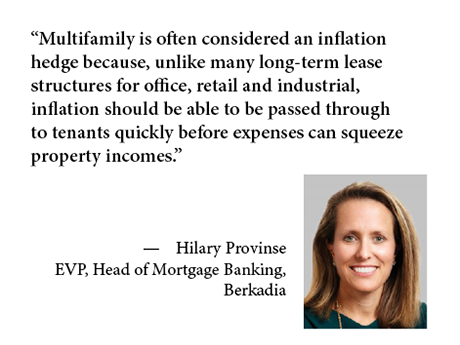2021 was an exciting year in the multifamily financing market, and for Berkadia mortgage banking — we originated over $40 billion in volume for our clients across our various lender programs, an increase of 50 percent over our 2020 volumes.
Every lender in the market demonstrated a strong appetite for originating loans and increased their holdings of mortgages, which was crucial given that the Federal Housing Finance Agency (FHFA) lowered the caps for Fannie Mae and Freddie Mac to $70 billion each. While the final numbers haven’t been released yet, the Mortgage Bankers Association (MBA) projected the market would originate $578 billion of loans backed by commercial real estate in 2021, a 31 percent increase from 2020 ($442 billion) and just below 2019’s record volume of $601 billion.
The fundamentals of the multifamily sector drove unbelievable rent growth, which in turn drove increased investor interest. In 2021, we advised on 762 investment sales transactions, totaling close to $27 billion in volume, a truly record-breaking year for us! This tremendous investor appetite brought about an enhanced need for financing, and often more creative financing.
With the government-sponsored enterprises (GSEs) more limited, life companies and commercial banks answered the call, but the biggest story of 2021 was the emergence and competitiveness of debt fund and bridge options. Over 100 funds were in the market offering competitive rates and proceeds last year, often making them more attractive compared with established options.
As we kick off 2022, Berkadia anticipates a continuation of 2021 trends. Similar capital sources will pick up the slack where the GSEs may still be limited, including the always-important life company, bank and debt fund executions. Fannie Mae and Freddie Mac will continue to be benchmarks for the multifamily financing industry. The FHFA has raised the 2022 caps to $78 billion for each GSE, and they will require that at least 50 percent of their multifamily business be mission-driven affordable housing and at least 25 percent be affordable to residents at or below 60 percent of AMI, up from 20 percent in 2021.
Looking forward at 2022 and interest rates, I wish I had my crystal ball, but despite volatility and widening over the past 15 months, when we look at rates and pricing for multifamily lending, it has still never been better.
Multifamily is often considered an inflation hedge because, unlike many long-term lease structures for office, retail and industrial, inflation should be able to be passed through to tenants quickly before expenses can squeeze property incomes. From our perspective, moderate inflation isn’t too worrisome, unless it gets high and forces a hawkish Fed.
Further, the economy is expected to continue on a more normalized path of growth going forward, supported by significant fiscal and monetary policies. Ten-year treasury yields have jumped up in recent weeks, however, they still remain historically low, despite being up over 100 basis points from extreme lows a year ago. This rise reflects more of a healthy return to sustainable levels than a significant rise in interest rates.
In sum, we see many reasons to be enthusiastic about the opportunities in multifamily markets this year. Fannie Mae and Freddie Mac will continue to set the standard for multifamily lending; however, strong life company, bank and debt fund appetites will compete heavily again in 2022, and fill the needs not met by the GSEs or HUD. We look forward to continuing to offer our clients a diverse roster of lending sources to meet their needs in the year ahead!
— By Hilary Provinse, EVP, Head of Mortgage Banking, Berkadia. This article is posted as part of REBusinessOnline’s Finance Insight series. Click here to subscribe to the Finance Insight newsletter, a sponsored four-part newsletter series, followed by several video interviews with leading lenders and financial intermediaries, delivered to your inbox in February 2022.


